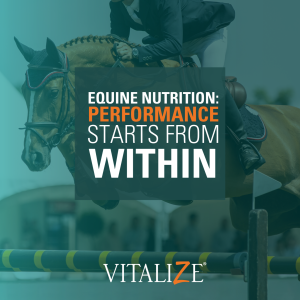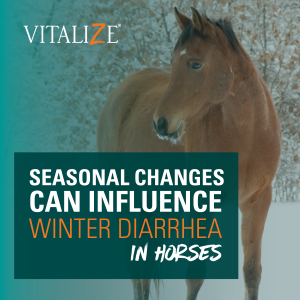
Forage, such as hay and pasture, should form the foundation of a horse’s diet. High-quality forage provides essential fiber, vitamins and minerals. Horses should have access to forage throughout the day to promote natural grazing behavior and maintain digestive health.
Horses are hindgut fermenters. What does this mean, exactly? To most, this simply means the fecal matter you clean up comes packaged in nice little balls. However, it is a bit more complex than that.
That’s why the BioZyme® team wanted to break down hindgut fermentation in horses and how to care for their digestive health. This information includes not only what products can help you support your performance horses, but where you can find a dealer for quality Vitalize Equine products.
We’re your one-stop-shop for all things horse digestive health.
Hindgut vs. Foregut
Rhinos, rabbits, some rodents, koalas and horses are all hindgut fermenters. To break down this term, you must first understand the anatomy of the equine digestive system.
The horse’s digestive system is broken into two primary components:
Foregut
The foregut—immediately following the esophagus—is made of the stomach and the small intestine. It is where grain can be broken down through the digestive enzymes in the stomach and further absorbed in the small intestine.
Most fiber, like your horse’s hay cannot be digested by the foregut’s enzymes. This fiber is instead sent to the hindgut and processed using the body’s symbiotic microorganisms, more commonly known as the “bugs” in the gut.
Hindgut
The hindgut—succeeding the small intestine toward the back of the horse—contains the cecum and the colon. It is where fermentation of fiber occurs. This digestion of feed in the cecum and colon by the animal’s microbes is known as hindgut fermentation. Hindgut fermentation is a vital part of your horse’s digestion and health.
Why is Hindgut Fermentation Important?
Hindgut fermentation allows horses to extract energy and nutrients from plant material that would otherwise be indigestible.
It is a slow and continuous process, which is one reason why horses graze or eat small, frequent meals throughout the day to keep the fermentation process going.
The microbial population in the hindgut is highly sensitive to dietary changes, so it’s important to gradually introduce new feeds to avoid upsetting the balance of these microorganisms.
How does the hindgut impact health?
The hindgut and hindgut fermentation play a crucial role in horse health, impacting various aspects of their well-being.
First, hindgut fermentation is essential for breaking down complex carbohydrates, such as cellulose and hemicellulose, found in plant materials like forage (hay and grass).
Microorganisms in the hindgut ferment these compounds into volatile fatty acids (VFAs), which serve as a significant energy source for the horse. This process ensures that horses can extract energy and nutrients from fibrous plant material, which is a primary component of their natural diet.
Additionally, proper hindgut fermentation is vital for maintaining a healthy body weight and condition in horses. This is because VFAs produced during fermentation provide a substantial portion of the horse’s energy needs.
When hindgut fermentation is efficient, horses can meet their energy requirements, which is crucial for growth, maintenance and physical performance.
Moreover, hindgut fermentation helps maintain a stable pH balance in the cecum and colon, preventing harmful changes that could lead to digestive disorders. A healthy microbial population in the hindgut also aids in the breakdown of other nutrients, such as proteins and B vitamins, contributing to overall health.
Your horse’s digestive system is a delicate ecosystem.
However, it’s important to note that abrupt dietary changes or the consumption of excessive starches can disrupt hindgut fermentation and lead to conditions like colic or laminitis. You might know that the horse’s stomach is about the size of a football. The stomach is found in the foregut and can only hold about 2-3 gallons at one time.
Things go awry when that undigested feed gets pushed into the hindgut, where it doesn’t belong. The hindgut is made solely for fermentation. Having undigested grains inside it is harmful.
That’s why proper nutrition management is essential for maintaining the health of a horse’s hindgut.
Be Proactive in Horse Care
Horses are natural grazers. Humans often disrupt that natural tendency, especially when we ask them to live a competitive lifestyle. They are kept in stalls or hauled in trailers, and are only grazing or eating forage for a limited amount of time each day. Therefore, we must now work to proactively control our management programs.
7 Tips for Quality Horse Digestive Health
Access to clean, fresh water is essential for digestion, hindgut fermentation, temperature regulation and overall health.
We offer 7 tips to help your horse win the game against digestive upset.
Feed smaller meals often
Feed your horse 3-4 times each day, if possible, since the stomach is so small. This will help reduce the overflow of undigested grains into the hindgut.
Ensure your horse has free-choice hay
As mentioned above, the equine digestive tract was created to slowly graze throughout the day. That means big bulk meals can be problematic for their digestive process.
If you don’t have a setup that allows for foraging, an effective proactive care solution is providing free-choice hay to help reduce digestive upset.
Reduce unnecessary stress.
When your horse is stressed, it goes into “fight or flight” mode. This stimulates the sympathetic nervous system. In this situation the body will inhibit digestion and prioritize organs like the heart, since it is more vital.
For example, if a horse needs to run away from a predator, digestion becomes a low priority physiologically. Our goal is to always keep digestion running smoothly, so reducing stimulating stressors is key to a happy animal.
Provide plenty of water
Horses can drink large volumes of water, especially in hot weather or during physical activity, so a consistent and clean water supply is vital.
Make dietary adjustments gradually
Any changes to a horse’s diet should be made slowly over time. This allows your horse’s delicate digestive system to adapt. Sudden changes can disrupt hindgut fermentation and lead to issues.
It can lead to a drop in the pH causing conditions like laminitis, colic, hindgut ulcers or acidosis. On a competitive schedule, this can be tricky to get right. This partially explains why digestive upset is so prevalent in the competition horse.
Pay attention to vitamins & minerals
Horses require a balance of essential minerals and vitamins, including calcium, phosphorus, magnesium and various vitamins. These nutrients are crucial for bone health, muscle function, and overall well-being. A well-formulated commercial horse feed or supplement can help meet these requirements.
Add research-proven digestive health supplements
Maintaining more good bugs in the gut than bad ones will help your horse ferment its feed effectively. At the same time, it reduces fluctuations in the gut pH that cause digestive issues. By incorporating a research-backed supplement into your program, like Vitalize , you can assist your horse in keeping a balanced gut.
Vitalize products are powered by AO-Biotics® Amaferm®, a research-proven prebiotic designed to enhance digestibility. Digestive supplements can also enhance gut health and reduce incidences of colic.
Vitalize for Hindgut Health and Digestion
Vitalize offers several products to give your horse a #goodgutfeeling. Want to find a dealer?
All of these products are easy to use and contain Amaferm to increase digestibility.
- Vitalize® Equine Digest More® Plus is a pelleted supplement for horses designed to support hindgut health and digestion of nutrients. It contains MOS (mannan oligosaccharide) to help normalize hindgut microflora and support the immune system. In addition, biotin and zinc promote healthy skin, hair and hooves. It is available in both 10- and 40-pound bags.
- Vitalize® Equine Free Choice is a highly fortified, free-choice vitamin and mineral supplement for horses of all ages and stages while on pasture. This product is fortified with organic trace minerals and high levels of vitamin E, biotin, and B vitamins. It also contains garlic to help deter insects and is available in a 50-pound bag.
- Vitalize® Equine High Performance is a pelleted supplement highly fortified with vitamins and minerals designed to support the nutritional needs of performance horses. This supplement is fortified with vitamins, minerals and organic trace minerals. High levels of calcium also help maintain proper gut pH. It comes in a 40-pound bag.
- Vitalize® Equine Protein Pellet is a pelleted, natural protein supplement for horses, fortified with vitamins and minerals. It provides 28% natural protein while being fortified with vitamins, minerals and organic trace minerals to balance rations. It is available in a 40-pound bag.
- Vitalize® Equine Gel is a prebiotic and nutrient-rich gel for horses designed to give immediate support to the digestive and immune system. In addition to Amaferm, it also contains MOS, to help normalize hindgut microflora and support the immune system. Equine Gel works fast to support appetite and hydration, as well as to get the gut back on track after any occasional digestive upset.
Backed By Science
Vitalize products are research-proven, and our manufacturing facility utilizes an ionophore-free closed production system to ensure a safe, accurate product. In addition, BioZyme® Inc., the maker of Vitalize, is a member of the National Animal Supplement Council (NASC). All Vitalize products carry the NASC Seal, meaning they are produced under some of the highest quality standards of any equine supplements on the market.
Keeping a horse’s hindgut healthy does not need to be a challenge. Implement some preventative maintenance tips above with one of the Vitalize products powered by Amaferm. This combination keeps the “bugs” in the gut in check, while creating the perfect recipe for #agoodgutfeeling.
What do Vitalize Users Say?
We can tell you the benefits of Vitalize all day. However, we’d prefer to share with you what some top equestrians say about using our products.
“A happy horse is a horse that’s going to perform, and if they are not 100%, they can’t do their job. In a competition like professional barrel racing, you must have your horses at their best all the time. If you don’t have your horse at its best, somebody else does. Being reassured that my horses have that Vitalize supplement and they are feeling good, is one less thing for me to worry about. If they aren’t feeling good, and time comes down to a one-hundredth of a second, everything counts. So, you have got to have them tip-top and ready to go,” said Emily Miller-Beiesl, Professional Barrel Racer.
Grant Seger, Professional Rider and Trainer at Grant Seger Sport Horses agrees.
“We absolutely love Vitalize! We have seen huge success with our show jumpers since they have been on Vitalize Equine Digest More Plus. They have all gone up a girth size, their coats have gotten darker, richer, and more dappled, and they are drinking more water. They also travel better now that they are on Vitalize. It makes the gut healthy, and I wish everyone knew about it!”
Want to Learn More?
Are you trying to decide which Vitalize product is right for your horse? Check out our Vitalize Product Navigator to determine the proper products for your management scenario.
Already using some Vitalize products, but you want to try more or different ones? You can buy them here.
Looking to buy the products locally? Use our online dealer locator to find the dealer nearest you!
If you’re not seeing a dealer in your area but still want to support local businesses, why not refer a dealer?

